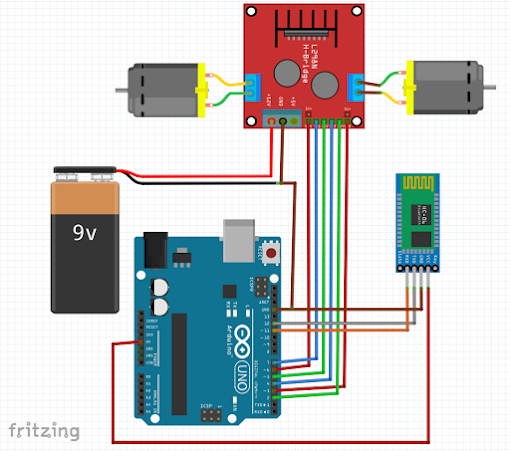RC Car using L298N, HC-06, and Arduino Uno
With this article, we will create a remote control (RC) car with the use of HC-06 bluetooth module to make it wireless and L298N motor driver to control speed and direction of rotations of the motors.
Materials:
1. Arduino Uno as the main board
2. HC-06 bluetooth module to receive commands via bluetooth communication protocol.
3. L298N motor driver module
4. DC motors to move the RC car.
Video Demonstration:
Source Code:
#include "SoftwareSerial.h"
#define IN3Br 2
#define IN4Br 4
#define PWMBr 3
#define IN1Al 7
#define IN2Al 5
#define PWMAl 6
#define HC_06_Rx 12
#define HC_06_Tx 11
#define NORMAL_SPEED 60
#define TURNS_SPEED 10
SoftwareSerial swSerial(HC_06_Rx,HC_06_Tx);
String cmd="";
bool isAlEnabled = false;
bool isBrEnabled = false;
byte PWMAl_val = 100;
byte PWMBr_val = 100;
void setup() {
// put your setup code here, to run once:
Serial.begin(9600);
swSerial.begin(9600);
pinMode(IN3Br, OUTPUT);
pinMode(IN4Br, OUTPUT);
pinMode(PWMBr, OUTPUT);
pinMode(IN1Al, OUTPUT);
pinMode(IN2Al, OUTPUT);
pinMode(PWMAl, OUTPUT);
digitalWrite(IN3Br, LOW);
digitalWrite(IN4Br, LOW);
digitalWrite(PWMBr, LOW);
digitalWrite(IN1Al, LOW);
digitalWrite(IN2Al, LOW);
digitalWrite(PWMAl, LOW);
swSerial.println("Setup Complete");
}
void loop() {
// put your main code here, to run repeatedly:
checkSerial();
}
void checkSerial() {
//Read data from Serial
while(Serial.available()>0){
cmd+=(char)Serial.read();
}
while(swSerial.available()>0){
cmd+=(char)swSerial.read();
}
//Select function with cmd
if(cmd!=""){
cmd.trim(); // Remove added LF in transmit
// We expect Command from bluetooth
if (cmd.equals("S")) {
swSerial.println("Braking");
brakeVehicle();
} else if(cmd.equals("R")) {
swSerial.println("Right turn");
turnVehicleRght();
}else if (cmd.equals("L")){
swSerial.println("Left turn");
turnVehicleLeft();
}else if(cmd.equals("F")){
swSerial.println("Moving forward");
moveVehicleForward();
}else if(cmd.equals("B")){
swSerial.println("Moving backward");
moveVehicleBackward();
}
cmd=""; //reset cmd
}
}
void brakeVehicle () {
digitalWrite(PWMBr, LOW);
digitalWrite(PWMAl, LOW);
}
void turnVehicleRght() {
analogWrite(PWMBr, TURNS_SPEED);
analogWrite(PWMAl, NORMAL_SPEED);
}
void turnVehicleLeft() {
analogWrite(PWMAl, TURNS_SPEED);
analogWrite(PWMBr, NORMAL_SPEED);
}
void moveVehicleForward() {
digitalWrite(IN3Br, HIGH);
digitalWrite(IN4Br, LOW);
analogWrite(PWMBr, NORMAL_SPEED);
digitalWrite(IN1Al, HIGH);
digitalWrite(IN2Al, LOW);
analogWrite(PWMAl, NORMAL_SPEED);
}
void moveVehicleBackward() {
digitalWrite(IN3Br, LOW);
digitalWrite(IN4Br, HIGH);
analogWrite(PWMBr, NORMAL_SPEED);
digitalWrite(IN1Al, LOW);
digitalWrite(IN2Al, HIGH);
analogWrite(PWMAl, NORMAL_SPEED);
}
If you found this tutorial helpful, please consider supporting me by sharing this to your friends. You may leave your comments and suggestions in the comment box.
Thank you and have a good day.








